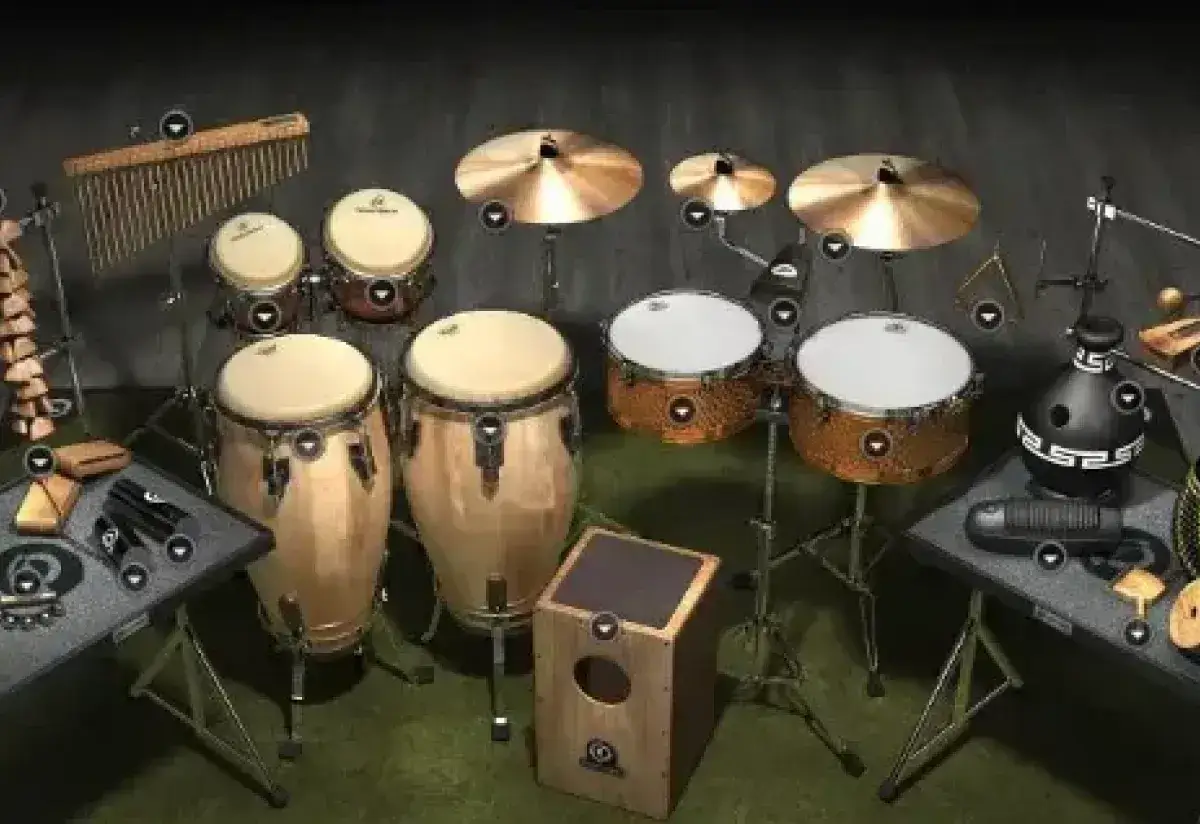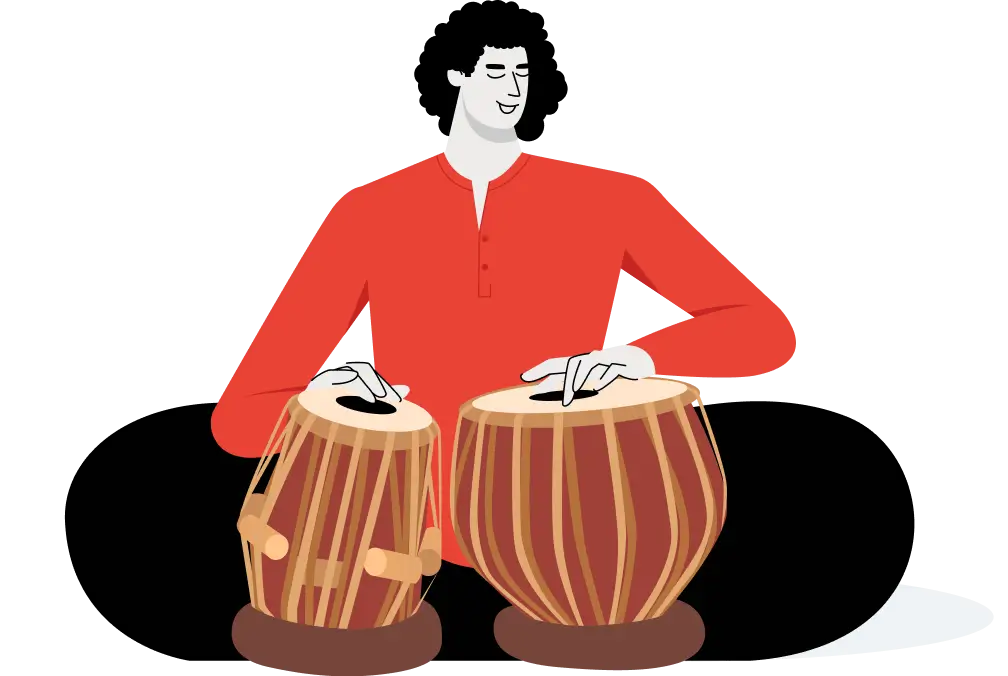Overview of Cajon Drum
The cajon instrument is a hollow box-shaped Latin percussion instrument that has been around for centuries but only gained worldwide popularity in the last few decades. When wondering what a cajón is, look no further than the translation of the Spanish word ‘cajón,’ literally a ‘crate.’ This simple wooden instrument may also be called a cahon or box drum, although it is not classified as a drum because it doesn’t have a membrane. Of Afro-Peruvian origin, this unpitched idiophone is a staple of Coastal Peruvian music, as well as a popular accompaniment to the musical styles of Latin folk, flamenco, jazz, and rumba.
A cajón is typically in the shape of a rectangular box, sized around 12 in x 12 in x 18 in, although exact measurements vary between cajón makers. The body of the instrument is made of wood and features six sides. For the five non-playing sides of the box, sheets of hardwood 3/4 inch (2 cm) thick are used. The striking side of the box is called the ‘tapa,’ meaning ‘top.’ The tapa is even thinner than the rest of the sides at 1/8 inch (3 mm). The cajón also features a sound hole, which acts as an amplifier for the tones produced by the cajón. The placement of the cajón is determined by the manufacturer, with different placements producing different effects on the sound produced by the instrument.
Cajón bodies are made from a wide variety of materials, each giving the instrument a distinct sound. Traditional cajóns were made from woods like beech, birch, mahogany, and oak, and the majority of cajóns that can be bought today are still made from these woods. These dense hardwoods produce a deep, bass sound when the cajón is played. Cajón tapas are typically made from plywood, or several layers of thin wood which gives the tone a high, crisp sound. Modern cajóns are also made from plastic and fiberglass. Although these materials change the tone of the instrument, they are stronger, more durable, and louder than traditional ones.
History of Cajón
The cajón was developed by African slaves in Coastal Peru during the 18th century. Thought to be a descendant of other box-shaped percussion instruments from West Africa, the cajón was adapted from shipping crates—most likely tea chests being delivered from Spain, which were plentiful and made from thin wood. Traditional Afro-Peruvian cajóns are still somewhat similar to the original shipping crates and remain an important part of Peruvian folk dance and Afro-Peruvian culture. In 2001, the cajón was declared a part of Peru’s national heritage by the Peruvian National Institute of Culture.
When slavery in Peru ended toward the end of the 19th century, Afro-Peruvian culture expanded and lead to the experimentation and evolution of music and the arts. During this time, cajóns were made from different kinds of boxes, including dresser drawers and handmade crates. In the early 1900s, the cajón became had a more commonly used design and became an integral part of musica criolla, the genre of music popular in Afro-Peruvian coastal communities. The cajón remained isolated from other musical genres for the majority of the next century, until the 1950s when Afro-Peruvian artist Nicomedes Santa Cruz popularized musica criolla outside of Peru. A decade later, a large musical group called Peru Negro that’s still active today further popularized the musical genre, bringing the cajón all over the world.
In contemporary music, the cajón has grown in popularity, especially in acoustic, minimalist performances where a full drum kit would be overpowering. Today, the cajón can be heard all over the world in blues, alternative rock, pop, funk, jazz, and even Irish folk music. In the 2000s, some drummers have also been known to replace the bass drum of a kit with a cajón, giving the drum set a unique Latin sound. Today, the cajón continues to be a popular instrument in percussion ensembles, frequently heard all over Latin America.
Types of Cajóns
In addition to the traditional Afro-Peruvian cajón, there are varieties of the instrument that are popular in other Latin American countries.
Cajón de tapeo – Also called a tapeador, this type of cajón is popular in Mexico. Although the instrument is similar to traditional Peruvian cajóns, the manner in which it is played is different. Rather than sitting on the instrument, the player sits on a small bench before the cajón. The instrument is played by holding a wooden block to the tapa and hitting it alongside the block with the player’s bare hand. The tapeador is a popular accompaniment to Mexican guitar and vihuela music.
Cajón de rumba – This is the Cuban version of the cajón, a popular accompaniment to rumba music. Made from fish crates in the 19th century, the instruments were adapted by Afro-Cuban dockworkers in the style of the tumbadora, with multiple sizes. In fact, these cajóns are thought to be the precurses to modern conga drums. Although replaced by conga drums, the cajón de rumba is still used in traditional rumba music.
Modern cajóns can come with different modifications, including electronic amplification, adjustable snare wires or bells attached to the inside, flared sound holes, a pedal, or adjustable slides in addition to the sound hole. Because of the relatively simple construction of the cajón, they can be altered by the player to meet their needs. Cajóns are also one of the few instruments that can be handmade moderately easily, making customization popular. While the traditional cajón is both portable and versatile, there are also travel cajóns that collapse into a flat-pack case.
Playing Techniques
Traditionally, the cajón player sits on top of the instrument (with the rectangular box sitting vertically), while striking the tapa between the knees. The cajón may sit on the ground or be tilted at a slight angle with the box resting on the edge of the bottom. The player strikes the tapa with the palm and fingers in different positions to achieve a variety of sounds. Below are some of the most commonly used strokes.
Bass tone: Strike the middle of the tapa with a flat hand, hitting the face with both the palm and fingers slightly apart, and allowing the hand to bounce off the instrument immediately after impact. This stroke is made only a few inches from the tapa and creates a warm, full tone.
High tone: Strike the top corner of the tapa with the palm, allowing the fingers to strike the two two-to-four inches of the tapa face. The fingers must be relaxed and kept slightly apart to achieve the ‘pop’ sound. This is similar to the slap tone popular in Latin drumming.
Pressed tone: Strike the top corner of the tapa with the flats of the fingers held together, leaving the fingers in contact with the surface after striking it. This produces a short, staccato sound.
While the instrument was traditionally played only with bare hands, it’s also common to play the cajón with a variety of tools, such as sticks or brushes popular with other percussion instruments.
Mechanics
The cajón is an unpitched instrument, meaning it can’t be tuned. However, the pitch of a cajón can vary depending on the materials used, the placement of the sound hole, the thickness of the materials, and the environment the instrument is played in. Thinner and lighter materials produce a higher pitch, while thicker and heavier materials produce a lower pitch. The playing area of the tapa face will produce different pitches depending on where it’s struck. The middle of the tapa produces a lower, bass sound, while the edges achieve a higher tone.
Famous Cajon Players
List of Famous Cajon Players from around the World
1. Alex Acuna
2. Heidi Joubert
3. Leon Mobley
4. Monojit Datta
5. Paul Jennings
6. Rafael Santa Cruz
7. Rubem Dantas









